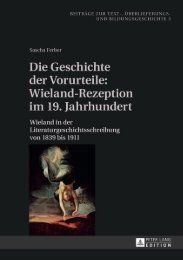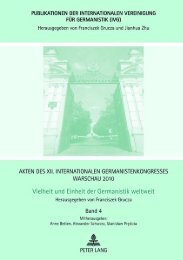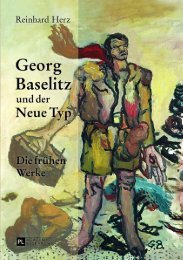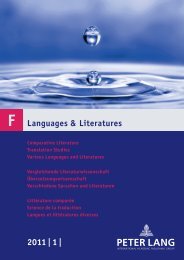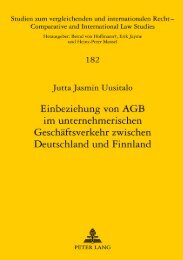Extract (PDF) - Peter Lang
Extract (PDF) - Peter Lang
Extract (PDF) - Peter Lang
Create successful ePaper yourself
Turn your PDF publications into a flip-book with our unique Google optimized e-Paper software.
10 Fernanda Peñaloza<br />
But of course, it was not only nineteenth-century anthropological<br />
curiosity that became integral in shaping images of Patagonia, so too, were<br />
aesthetic frames. Indeed, in the travel-writing tradition the language of<br />
aesthetic landscape transformed the Patagonian geography into a sublime<br />
experience in which the evocation of an overpowering nature obscures the<br />
historical and cultural grounds of the appropriative power of colonial discourse<br />
and colonial enterprises. W. H. Hudson in Idle Days in Patagonia<br />
synthesises the overpowering effects of the Patagonian landscape:<br />
Judging from my own case, I believe that we have here the secret of the persistence<br />
of Patagonian images, and their frequent recurrence in the minds of many who have<br />
visited that gray, monotonous, and in one sense, eminently uninteresting region. It is<br />
not the effect of the unknown, it is not imagination; it is that nature in these desolate<br />
scenes moves us more deeply than in others. (193)<br />
Even though, as Joy Logan has observed, Patagonia “is a land locked<br />
into the fiction of its existence” (67) both the real and imaginary possession<br />
representations. The generic term “Patagonian Indian” – as well as the many labellings<br />
and categorisations created around it, including those that aimed at being accurate<br />
and descriptive – arose in specific historical contexts and asumed a broad range of<br />
forms with concomitant political and cultural implications. Although contributors<br />
to this volume do not necessarily have in common similar theoretical and ideolgical<br />
views, what authors do share is an awareness of the implications of this need for classification<br />
of the indigenous population of Patagonia. Hence, even when the authors<br />
are not explicitly clarifying their position regarding this question, the reader should<br />
interpret that when the term “Indian” is being used, this choice does not respond<br />
to the attempt to describe indigenous peoples, but rather to contribute to a critical<br />
awareness of the creation and trajectory of images and ideas on Patagonia. In fact,<br />
when the authors reproduce the term “Indian” as it appears in some descriptions,<br />
they are exposing how, when and by whom such terminology is being used, as in<br />
many cases, it is virtually impossible to clarify to which specific indigenous group<br />
the term is being applied. Therefore, the indigenous peoples of Patagonia, who were<br />
scrutinised and written about in many works analysed here, are discussed in this<br />
volume in terms of their represenation, not because we are unaware of the heterogeneity,<br />
mobility and variety of indigenous identities, but rather because this is our<br />
workable approach to the study of the representations of indigenous peoples in the<br />
region.




